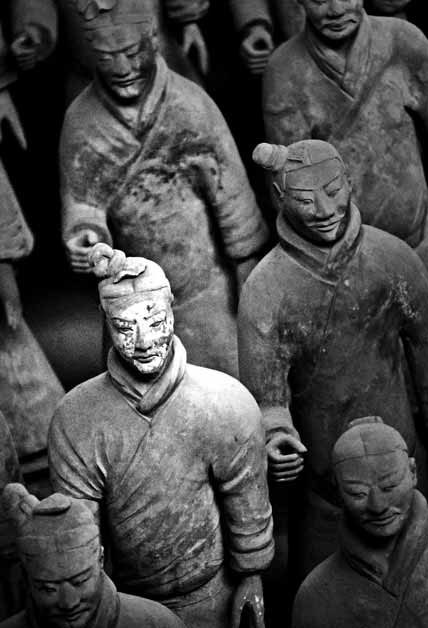

The ancient terracotta warriors are displayed in a new, modern way at the show China's Terracotta Warriors: The First Emperor's Legacy. Chen Jia / China Daily 3-D image technology enables visitors to enjoy the show and get a better understanding of the relics. Mai Tian / for China Daily
They were a Chinese emperor's elite guards, faithful to the last. China's most famous warriors are back in San Francisco, and Chen Jia is on site to record their adventures.
Returning to the City by the Bay for the first time in 20 years, China's Terracotta Warriors are striding into San Francisco, looking better than ever. This time, they will come alive with the help of 3-D image technology.
By spending a few minutes downloading an Apple app onto your iPad, iPhone or iPod Touch, and focusing the device on a poster for the exhibition at the Asian Art Museum, visitors can breathe life into this collection of terracotta sculptures that depict the armies of China's first emperor, Qin Shihuang (259-210 BC), and are known as the Eighth Wonder of the Ancient World.
But don't be surprised if a figure walks out of the picture. It's due to a process known as augmented reality (AR) technology that superimposes 3-D objects onto space.
"The idea of our approach to works of art is to bring them back to life. Connecting us to life," says Marco Centin, the exhibition designer who used multimedia and illustrations to create context around the artifacts.
His goal is to enhance the American visitors' understanding of the presentation, as well as to give it a more intuitive dimension.
"In other words, we want our visitors to not only enjoy the great beauty of the art works, but also the stories about them, and to imagine how they would have looked in their own time," the designer says.
The museum and Magma Studios, a Singapore-based games technology company, created the app together with the Asian Civilizations Museum, also of Singapore.
In 1985, the Shaanxi provincial cultural heritage bureau and the Minneapolis Institute of Arts collaborated on a small exhibition of the warriors, which were discovered by local farmers near Xi'an, Shaanxi's provincial capital, in 1974.
The exhibition's success encouraged exchanges between Shaanxi and Minnesota. About three years ago, MIA along with the Asian Art Museum extended an invitation to the Shaanxi cultural heritage bureau to organize China's Terracotta Warriors: The First Emperor's Legacy.
The institutions worked together on the exhibition for about two years.
"Some of the objects traveled for the first time outside China", so the "knowledge around them" is fresh, says Jay Xu, the director of the Asian Art Museum in San Francisco.
"There have been many new discoveries in past years, so we're able to present to the American public an exhibition that incorporates multimedia, when appropriate, to enhance (the audience's) understanding, as well as offer a dynamic element," he says.
One of the new attractions is a life-sized bronze bird, which visitors can see fly through thanks to the magic of the app.
Another highlight is a bronze bell which sings to visitors.
"We cannot strike the bell to make it ring because it's a very precious object," Xu says. "So we replicated the bell sound by using 3-D and high acoustic technology."
Those technologies, he says, "had not been developed years ago, for the first exhibition in San Francisco".
Showcasing one of the greatest archaeological discoveries in modern times, the exhibition's opening weekend attendance set a museum record, beating the previous attendance by more than 60 percent. Since then, it has been drawing 2,000 visitors a day.
The museum's anti-earthquake design is expected to protect the exhibits from being damaged in a tremor, which could possibly occur in San Francisco.
The museum is designed to survive earthquakes as strong as the major 1906 San Francisco earthquake with less than 1 percent damage, according to authorities. The building is supported by more than 200 base isolators and specialized shock absorbers.
A moat has also been dug around the perimeter of the building, to allow it to move freely in an earthquake.
"I am proud to say that we are one of the safest buildings in San Francisco," Xu says.
Vince Avalos, the Asian Art Museum's mount-maker, also built support structures to secure every terracotta warrior, protecting them from seismic activity.
He traveled to the exhibition's previous venue in Minneapolis, months ago, to take measurements for the mounts used in the San Francisco presentation. Then he handcrafted pedestals for each terracotta figure.
The mounts will accompany the warriors when they return to China, so Chinese museums can use them in future displays.
China's Terracotta Warriors: The First Emperor's Legacy is on view until May 27.
Contact the writer at chenjia@chinadailyusa.com.
By Chen Jia
